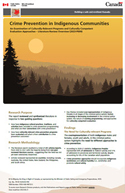Crime Prevention in Indigenous Communities: An Examination of Culturally-Relevant Programs and Culturally-Competent Evaluation Approaches – Literature Review Overview
Products

Full Text Crime Prevention in Indigenous Communities: An Examination of Culturally-Relevant Programs and Culturally-Competent Evaluation Approaches (HTML)
Crime Prevention in Indigenous Communities: An Examination of Culturally-Relevant Programs and Culturally-Competent Evaluation Approaches PDF Version
Summary Crime Prevention in Indigenous Communities: An Examination of Culturally-Relevant Programs and Culturally-Competent Evaluation Approaches (HTML)
Research Summary: Crime Prevention in Indigenous Communities PDF Version
Placemat Crime Prevention in Indigenous Communities: An Examination of Culturally-Relevant Programs and Culturally-Competent Evaluation Approaches – Literature Review Overview (HTML)
Crime Prevention in Indigenous Communities: An Examination of Culturally-Relevant Programs and Culturally-Competent Evaluation Approaches – Literature Review Overview PDF Version
Research Purpose
The report reviewed and synthesized literature in response to two guiding questions:
- How have Indigenous cultural practices, traditions, and activities been included in crime prevention programming and what are their connections with crime prevention?
- How have culturally-relevant crime prevention programs been evaluated and what is their contribution to crime prevention outcomes?
Research Methodology
- The literature search resulted in a total of 291 articles/reports, from 1983 to 2021 with the majority being from non-peer reviewed literature sources – suggesting that the field has not yet been extensively researched.
- Articles reviewed represented 22 countries, including Canada, Australia, the United States, New Zealand, the Philippines, and South Africa.
- Key themes included over-representation of Indigenous Peoples in all stages of the criminal justice system; factors increasing or decreasing involvement in the criminal justice system; the nature of existing programming; and approaches for culturally-competent evaluation.
Findings
The Need for Culturally-relevant Programs
The overrepresentation of both Indigenous males and females, youth and adults, in the criminal justice system highlights the need for different approaches to crime prevention.
- According to 2020-21 statistics, Indigenous Peoples represented 33% of admissions to federal custody and 31% of admissions to provincial and territorial custody, despite accounting for 5% of the Canadian adult population.
- Crime prevention approaches should incorporate Indigenous worldviews and cultural humility (i.e., sensitivity), and promote cultural safety.
Indigenous-specific Factors that Influence Involvement in the Criminal Justice System
Factors that increase involvement
- Colonialism
- Residential schools/Sixties scoop
- Systematic discrimination
- Socio-economic marginalization
Factors that decrease involvement
- Engagement in traditional/cultural practices
- Positive cultural identity
- Strong extended-family
- Community involvement
Culturally-relevant Programs
The review of culturally-relevant programs brought to light key elements of existing approaches and best practices that can provide direction for future crime prevention programs:
- Community Empowerment: Involve Indigenous communities in the design and implementation.
- Program Type: Ensure programs are adapted to different Indigenous populations.
- Holistic Approach to Healing: Incorporate Indigenous worldviews to address the root causes of behaviours and aid in healing.
- Importance of Cultural Elements: Include cultural elements (e.g., ceremonies, healing circles, land-based activities, etc.); involve Indigenous facilitators, leaders, and experts; and recognize and address the context of colonialism and its consequences.
- Resources: Secure long-term funding and involve culturally-appropriate facilitators and support workers.
- Impact of Programs: Conduct further research into the role and effectiveness of cultural program components, particularly those co-developed with Indigenous communities.
Culturally-competent Evaluation
A review of the evaluation of culturally-relevant programs uncovered current barriers, limitations, and risks associated with culturally-competent evaluation, as well as best practices and additional opportunities for future program evaluations.
| Current Challenges | Best Practices | Future Opportunities |
|---|---|---|
Relatively new area, limited to a small number of countries |
Designs that respond to key tenets of Indigenous evaluations |
Stronger links between federal governments and communities during development and implementation |
Reliance on mainstream/Western evaluation methods |
Co-construction of measures with Indigenous communities and leaders, ensuring community empowerment |
Positioning evaluators as advocates for the communities they work with |
Relationship barriers, particularly with building trust with communities |
Designs and implementation grounded in the cultural context of each individual community |
Use of dialogue and equal participation to co-develop evaluation approaches that mobilize community strengths |
Resource and capacity constraints, as well as data-related challenges (e.g., lack of data or inconsistent data) |
Presence of culturally-relevant evaluation components |
Various methods of knowledge sharing to suit the diversity of users and participants |
Barriers to accessing remote or under-resourced communities |
Consideration of factors such as trust, safe spaces, two-way knowledge sharing and cultural dissonance |
More research focused on the use and impact of Indigenous evaluation approaches |
- Date modified: